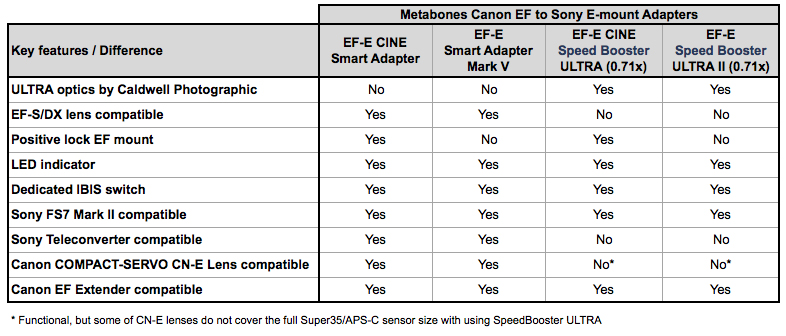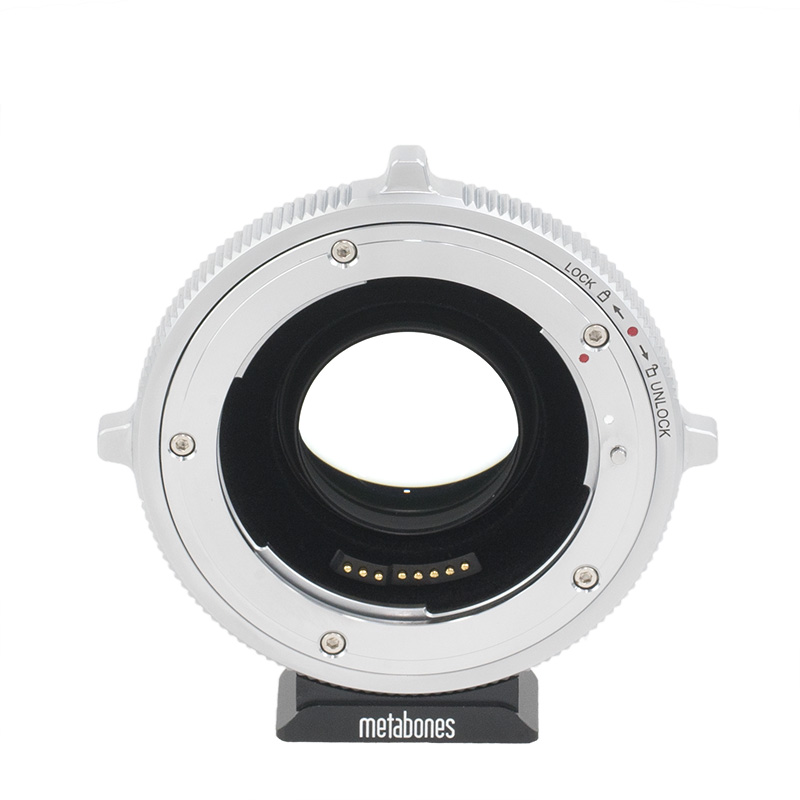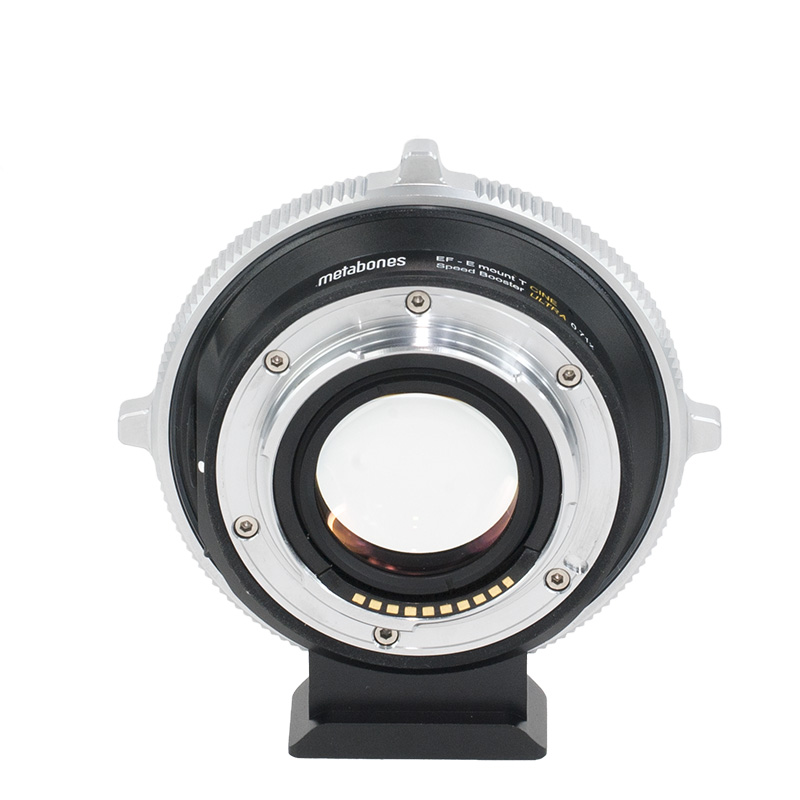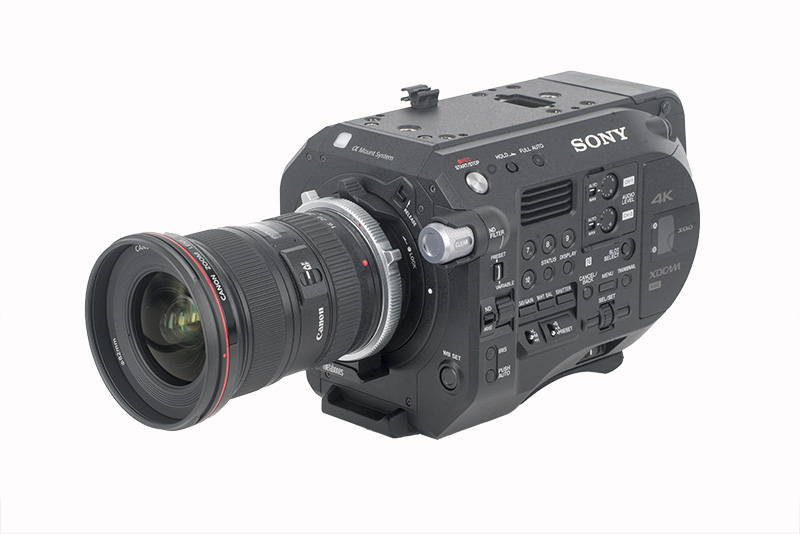Canon EF Lens to Sony E -mount T CINE Speed Booster ULTRA 0.71x

Key Features

Speed Booster ULTRA for E-Mount and X-mount cameras
Sharper corners, less distortion, reduced vignetting
New optical design: advanced 5-element/4-group optical design incorporating ultra-high index tantalum-based optical glass to achieve extraordinary optical performance with improved corner sharpness, distortion and reduced vignetting.
Like the revolutionary original Metabones Speed Booster announced in January 2013, the Speed Booster ULTRA has a magnification of 0.71x, and so it effectively reduces the crop factor of mirrorless cameras with DX-sized sensors, such as Sony E-mount and Fuji X-mount cameras, from 1.5x to 1.07x. However, the new ULTRA design makes very effective use of exotic materials at the furthest limit of glassmaking technology, and as a result is well corrected for use with virtually all full-frame SLR lenses regardless of exit pupil distance. Thus, the Speed Booster ULTRA performs extremely well with professional-grade f/2.8 zoom lenses such as the 24-70mm f/2.8 and 70-200mm f/2.8 zooms by Canon and Nikon to produce 17-50mm f/2.0 and 50-142mm f/2.0 high-speed zooms, respectively. Similarly, high-speed fixed focal length lenses such as a 50mm f/1.2 will be transformed into a 35.5mm f/0.9 lens with excellent contrast and resolution from the center all the way to the edges of the image. (More information can be found in the press release here)
| Features and benefits |
|
Limitations |
|
Metabones Exclusive
- Patented 5-element/4-group optical design incorporating ultra-high index tantalum-based optical glass by Caldwell Photographic in the USA.
- Patented positive-lock EF lens mount
- Store EXIF data (lens name, focal length and maximum/minimum aperture) for up to 2 manual lenses in the adapter.
- If both your lens supports optical image stabilization (OIS) and your camera supports sensor-shift, in-body image stabilization (IBIS), the choice is yours on which one to use, or have both of them work in harmony.
- Smooth iris support with the latest Canon (2009+), Tamron (SP series 2013+) and Sigma (2016+) lenses.
- Custom function button (called Focus Hold button) assignable to more than 50 functions, such as Aperture Preview and Eye-AF, on A9, A7 series, A6600, A6500, A6400, A6300 and A6100.
- Dedicated switch controls in-body image stabilization (IBIS) on Sony cameras equipped with SteadyShot INSIDE.
- Compatible with Sony FS7 Mark II camera.
- Cinema EOS lens (CN-E Compact-Servo) support, including power zoom, AF and auto iris.
- Rubber gasket protects E-mount connection from dust and moisture.
- Detachable tripod foot, compatible with Arca Swiss, Markins and Photo Clam ball heads.
Optical/Mechanical
- Increase maximum aperture by 1 stop.
- Increase MTF.
- Makes lens 0.71x wider.
- Felt material flocked inside to reduce internal reflection.
Electronic
- AF-C tracking during high-speed drive at up to 10fps on Sony A9, A7III and A7RIV.
- Fast contrast-detection AF on all E-mount cameras with most lenses.
- Pure phase-detection autofocus support on A9, A7RIV, A7RIII, A7III, A7RII, A7II, A6600, A6500, A6400, A6300 and A6100.
- Supports 5-axis in-body image stabilization of A7RIV, A7III, A7RIII, A7II, A7RII and A7SII. (Distance information from lens required; 3-axis IBIS if the lens does not transmit distance information.)
- Powered by camera body. No external power source required.
- LED indicator shows operation mode, OIS (optical image stabilization) activity and communication status.
- Efficient switched-mode power supply.
- Supports image stabilization (IS) lenses.
- Supports electronic manual focusing (e.g. EF 85/1.2L II and discontinued EF 50/1.0L)
- EXIF support (focal length, aperture, lens name)
- Distance and zoom display on VG and FS series camcorders, A9, A7 series, A6500 and A6300 (lens with distance information support required).
- Auto magnify (lens with distance information support required)
- Auto "APS-C Size Capture" on full-frame cameras with Canon EF-S lenses and many third-party DX lenses.
|
|
Optical/mechanical
- Full-frame lens required. EF-S/DX/DC/Di II lenses are NOT supported.
- Speed Booster ULTRA is designed to cover an APS-C image circle which is not big enough to cover a full-size 36mm x 24mm sensor. On a full frame camera body (A7 series, NEX-VG900) the camera needs to have "APS-C/Super 35mm" set to either "Auto" or "On".
Autofocus
- AF-C is supported on A9, A9II, A7RIV, A7RIII, A7SIII, A7IV, A7III, A7RII, A7II, A6600, A6500, A6400, A6300 and A6100 only.
- Continuous video AF is functional in Advanced mode only, but performance may be unsatisfactory.
- On Sony A9, only phase-detection autofocus is supported. Contrast-detection autofocus may not work satisfactorily.
- AF may not work if the maximum aperture of the lens plus any EF Extender or other teleconverter attached is smaller than f/8 before boost or smaller than f/5.6 after boost.
- The first few autofocus attempts are used to calibrate the lens and as a result may not lock successfully on the target. Half-press the shutter release button again and autofocus will lock successfully.
- Autofocus may have difficulty locking onto subjects which are very close to the nearest focusing distance of the lens.
- Autofocus accuracy depends heavily on the design and working condition of the lens. Lenses with hidden problems which may not be apparent on Canon DSLRs will lead to inaccurate and unreliable autofocus on Sony. Typical problems of this kind that we have seen include an unsmooth/erratic autofocus mechanism (e.g. getting stuck intermittently at a certain focusing distance), a faulty/worn-out distance encoder or other faulty/worn-out internal sensors.
Other
- No support for lens corrections such as peripheral shading, CA and distortion.
- Use of Canon Cinema lenses such as CN-E 18-80mm T4.4 for still photography is not supported. (Functional, but slower than lenses designed for still photography.)
- Some EF-mount lenses may make audible noises during iris changes and autofocus, which may be picked up by the built-in microphone of the camera during video recording. Use of an external microphone is advised. Some of the recently-introduced Canon-brand lenses are very quiet, however.
- Early Tamron VC lenses such as the AF 28-300/3.5-6.3 XR Di VC LD Aspherical [IF] Macro (model A20), AF 18-270/3.5-6.3 Di II VC LD Aspherical [IF] MACRO (model B003), SP AF 17-50mm F/2.8 XR Di II VC LD Aspherical [IF] (model B005) may not be able to freely switch between OIS and IBIS because they may not report IS activity status. Later Tamron VC lenses equipped with USD or PZD focus motors are fine.
- Some aftermarket battery grips may cause the aperture to change erroneously. This is a bug in the aftermarket battery grip but NOT arising from the Metabones Speed Booster. Turn off the aftermarket battery grip or use a genuine Sony battery grip.
|
Disclaimer: we are NOT licensed, approved or endorsed by Sony or Canon.
Description

Compatible Camera Bodies:
- Sony alpha A1 II, A1, A9 III, A9 II, A9, A7R V, A7R IV, A7R III, A7R II, A7R, A7S III, A7S II, A7CR, A7C II, A7C, A7S, A7IV, A7III, A7II, A7 (APS-C Crop mode)
- A6700, 6600, A6500, A6400, A6300, A6000, A5000
- ZV-E10 II, ZV-E10*
- ILME-FX30*
- ILME-FX2 (Crop mode)*
- PXW-FX9 (Crop mode)*
- PXW-FS7M2, PXW-FS5M2, PXW-FS5, PXW-FS7, NEX-FS700, NEX-FS100
- VENICE (Crop mode)*
- NEX-EA50, NEX-VG900, NEX-VG30, NEX-VG20, NEX-VG10
- NEX-7, NEX-6, NEX-5R, NEX-5N, NEX-5, NEX-C3, NEX-3
* for using the VENICE, FX and FS series cameras, please switch the adapter to Advance Mode(LED in red colour).
Lens compatibility chart
| Fast AF on all E-mount cameras. Max 10fps AF-C with A9 (Green Mode) and A7III / A7RIV (Advanced Mode) |
Phase-detect AF on A9II, A9, A7RIV, A7III, A7RIII, A7RII, A7II, A6600, A6500, A6400, A6300 and A6100 only. On other cameras, may not be able to contrast-detect AF accurately if at all. Max 3fps with A7III. |
|
Canon EF8-15mm f/4L USM Fisheye*
Canon EF17-35mm f/2.8L USM
Canon EF24-70mm f/2.8L II USM*
Canon EF24-105mm f/4L IS USM (Mark I)
Canon EF28-80mm f/3.5-5.6 III USM
Canon EF28-80mm f/3.5-5.6 II
Canon EF40mm f/2.8 STM*
Canon EF50mm f/1.2L USM
Canon EF50mm f/1.4 USM (1993)
Canon EF50mm f/1.8 STM*
Canon EF70-200mm f/2.8L IS II USM*
Canon EF70-200mm f/4L IS II USM*
Canon EF70-200mm f/4L USM (not IS)
Canon EF70-300mm f/4-5.6L IS USM*
Canon EF85mm f/1.2L II USM
Canon EF100mm f/2.8L IS USM Macro*
Canon EF100mm f/2.8 USM Macro (2000)
Canon EF100-400mm f/4.5-5.6L IS II USM*
Canon EF135mm f/2L USM
Canon EF200mm f/2.8L II USM
Canon EF300mm f/2.8L IS II USM*
Canon EF300mm f/4L IS USM
Canon EF400mm f/5.6L USM
Canon EF Extender 1.4x (all versions)
Canon EF Extender 2x (all versions)
Kenko Teleplus Pro 300 1.4x (note 1)
Kenko Teleplus Pro 300 2x (note 1)
Sigma 24-105mm f/4 DG OS HSM Art 013
Sigma 50-500mm f/4.5-6.3 DG OS HSM
Sigma 135mm f/1.8 DG HSM Art 017
Tamron 15-30mm f/2.8 VC USD A012 (G1)
Tamron SP 24-70mm f/2.8 VC USD A007 (G1)
Tamron SP 45mm f/1.8 VC USD F013*
Tamron SP 70-300mm f/4-5.6 VC USD A005
|
Canon EF24-70mm f/2.8L USM (Mark I)
Canon EF28-70mm f/3.5-4.5 II (1988)
Canon EF28-135mm f/3.5-5.6 IS USM
Canon EF35mm f/1.4L USM (Mark I)
Canon EF50mm f/1.8 II (1990)
Canon EF100mm f/2 USM
Canon EF100-400mm f/4.5-5.6L IS USM (Mark I)
Contax N Vario Sonnar 17-35mm f/2.8
Contax N Planar 50mm f/1.4
Contax N Vario Sonnar 70-200mm f/3.5-4.5
Contax N Planar 85mm f/1.4
Sigma 50mm f/1.4 DG HSM (not Art)
Tamron 28-300mm f/3.5-6.3 XR Di VC LD Aspherical [IF] MACRO A20
Tamron 28-300mm f/3.5-6.3 XR Di LD Aspherical [IF] MACRO A06
Tamron SP 150-600mm f/5-6.3 VC USD A011 (G1)*
|
| Phase-detect AF on A9, A7III, A7RIII, A7RII, A7II, A6500, A6400 and A6300. Not known if other cameras autofocus satisfactorily using contrast-detection, and it is not known if the maximum AF-C drive speed of 10fps with A7III & A7RIV can be achieved or not. |
Manual focus only |
|
Canon EF 11-24mm f/4L USM
Canon EF 14mm f/2.8L II USM
Canon EF 16-35mm f/2.8L USM
Canon EF 16-35mm f/4L IS USM
Canon EF 20-35mm f/3.5-4.5 USM
Canon EF 24mm f/1.4L USM
Canon EF 24-70mm f/4L IS USM
Canon EF 24-105mm f/4L IS II USM
Canon EF 28-300mm f/3.5-5.6L USM
Canon EF 35mm f/1.4L II USM
Canon EF 35mm f/2L IS USM
Canon EF 35-350mm f/3.5-5.6L USM
Canon EF 70-200mm f/2.8L IS USM (Mark I)
Canon EF 70-200mm f/2.8L USM (non-IS)
Canon EF 70-200mm f/4L IS USM (Mark I)
Canon EF 75-300mm f/4-5.6 IS USM
Canon EF 85mm f/1.8 USM
Canon EF 180mm f/3.5L Macro USM
Canon EF 400mm f/2.8L IS USM (Mark I)
Canon EF 500mm f/4L IS USM (Mark I)
Sigma 12-24mm f/4.5-5.6 (Ver I)
Sigma 20mm f/1.4 DG HSM Art
Sigma 24mm f/1.4 DG HSM Art
Sigma 35mm f/1.4 DG HSM Art
Sigma 50mm f/1.4 Art
Sigma 70-200mm F2.8 APO EX DG OS HSM
Sigma 85mm f/1.4 EX DG HSM
Sigma 150mm f/2.8 Macro
Sigma 150-600mm f/5-6.3 OS HSM Contemporary
Tamron SP 70-200mm f/2.8 Di VC USD A009 (G1)*
Tamron 70-300mm f/4-5.6 (not VC)
Tamron SP 90mm f/2.8 Macro
|
Canon TS-E 17/4L
Canon TS-E 24/3.5L
Canon TS-E 90/2.8L Marco
Samyang 35/1.4
Sigma 18-35/T2.0
Zeiss CP.2 25mm/T2.9
Zeiss CP.2 100mm/T2.1
Zeiss ZE Distagon 15/2.8
Zeiss ZE Distagon 18/3.5
Zeiss ZE Distagon 21/2.8
Zeiss ZE Distagon 25/2.8
Zeiss ZE Distagon 35/2
Zeiss ZE Planar 50/1.4
Zeiss ZE Makro-Planar 50/2
Zeiss ZE Planar 85/1.4
Zeiss ZE Makro-Planar 100/2
|
| Not supported |
|
Focus confirmation "chip" (e.g. Dandelion)
Tokina opera 50mm f/1.4 FF (note 2)
|
Notes :
- Lenses marked with an asterisk support smooth iris.
- Sony NEX cameras cannot display aperture values beyond f/1.0. If a f/1.2 Canon EF lens is used with Speed Booster ULTRA the resulting aperture is f/0.9 but the camera body displays the original aperture f/1.2 to the camera body. i.e, lenses slower than f/1.4 report boosted aperture to camera body; lenses at or faster than f/1.4 report original aperture to camera body.
- Some improperly-made M42 screw mount adapters may short the electronic contacts of the Speed Booster ULTRA and cause damage to the Speed Booster ULTRA and/or camera body.
- Many manual focus lenses (e.g. OM 28/2.8, OM 50/1.8, Leica R 15/3.5) have rear protrusions (spikes, levers, other appendages) which would damage the optics and/or housing of Speed Booster ULTRA They need to be modified before they can be safely used on Speed Booster Check and make sure there are no rear protrusions from the adapter/lens combination before using on Speed Booster. Scratches and damages caused by rear protrusions on Speed Booster are not covered by warranty.
- This Speed Booster ULTRA is NOT fully compatible with full-frame Sony A7 series. When Speed Booster® ULTRA is used with Sony A7 series, the camera will turn on the "APS-C Size Capture" mode automatically.
- Cannot be used due to unusually high current requirement.
List of manual focus lenses which REQUIRE MODIFICATION to be used on Speed Booster ULTRA
Many manual focus lenses have rear protrusions (spikes, levers, other appendages) which would damage the optics and/or housing of Speed Booster ULTRA. They need to be modified before they can be safely used on Speed Booster ULTRA. Check and make sure there are no rear protrusions from the adapter/lens combination before using on Speed Booster ULTRA. Scratches and damages caused by rear protrusions or by poor quality adapters are not covered by warranty. The following is an incomplete list of lenses known to be incompatible.
Contax/Yashica
Distagon 3,5/15mm |
Leica R
Super-Elmar-R 15mm
Elmarit R 28/2.8
Elmarit R 35/2.8
Summicron R 50/2 |
Nikon F
20/2.8 AI-S |
Olympus OM
OM 18/3.5
OM 21/2
OM 21/3.5
OM 28/2.8
OM 50/1.8 |
Pentax K
Every Pentax K-mount lens has a protruding fin and an aperture lever. It does NOT fit.
|
EF-E Product Matrix

Note: your PayPal receipt is your order confirmation. There is no separate email confirmation until shipment takes place.
Why Metabones®?
Since its inception, Metabones has been designing and manufacturing lens adapters recognized among professionals and enthusiasts as leaders in design and workmanship.
Contrary to the popular trend of other factories using an aluminum ring painted black on the camera-body-side, we instead take no short-cut but use precision-machined brass with chromium plating on both the camera-body and the lens sides of our adapters, in order to ensure smooth mounting, great appearance, and durability. The lens side of the adapter features a strong leaf-spring structure, strengthening the adapter-lens connection and ensuring tightness of the lens in order to reduce wear and prevent focus errors and optical alignment issues from appearing.
Metabones uses matte-black treatment to keep internal reflection to a minimum in order to maintain the maximum optical quality possible with the lens.
All Metabones Adapters follow this tradition of uncompromising precision, robust build quality and outstanding finish. Our new Smart AdapterTM series of products add industry-leading electronic interfacing technology from Canada, with true electronic control of the lens' aperture directly from the camera body.
Features
- Both camera-side and lens-side of the adapter are made of brass, precision-machined and plated with chromium.
- Satin surface finish - just like your OEM lens and camera mounts.
- Precise fit and solid connection - lens has no play, gap or wiggling when mounted on adapter and no adjustments are required to fit your lens.
- Designed to reach infinity focus while maintaining the correct registration distance required to maintain optical quality of CRC lenses or lenses with floating elements.
Our Smart AdapterTM series adapters have the following additional features
- True electronic integration of aperture diaphragm - let camera automatically choose aperture in P or S exposure modes, or dial in yourself on the camera body in A or M modes.
- EXIF data such as lens identification, focal length and aperture.












